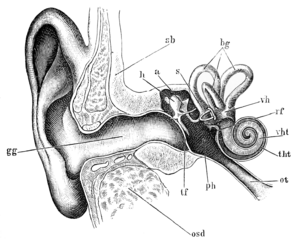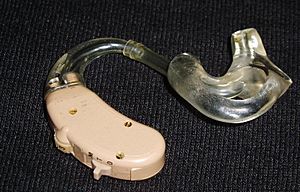Hearing facts for kids
Hearing is one of the five senses. Ears detect vibrations in the air. These vibrations are sounds. Most animal's can hear. Most land vertebrate's hear through ear's. Fish hear in several different ways. Many use their swim bladder to hear, and many use their lateral line.
In mammals, sound travels through three main parts of the ear to be heard. These are the outer, middle and inner ear.
- Outer Ear - This is the part of the ear that we can see called the pinna as well as the inside of the ear called the ear canal. Sound first travels through the pinna and ear canal then to the eardrum at the end of the canal which the sound makes vibrate.
- Middle Ear - Sound continues to travel deeper into the ear and is helped by three of the smallest bones in the body - hammer, anvil and stirrup - to reach the inner ear.
- Inner Ear - Here the sound reaches a small tube shaped like a snail shell, called the cochlea. Inside the cochlea is a fluid, which moves tiny hairs that send signals to the brain which interprets sounds for you to understand and hear.
Contents
Hearing underwater
Hearing threshold and the ability to localize sound sources are reduced underwater in humans but not in aquatic animals, including whales, seals, and fishes which have ears adapted to process water borne sound. Some research suggests underwater hearing in humans may occur through bone conduction but with poor localization. This is related to differences of the speed of sound in water vs air and the blocking of normal air conducted sound paths.
In vertebrates
Not all sounds are normally audible to all animals. Each species has a range of normal hearing for both amplitude and frequency. Many animals use sound to communicate with each other, and hearing in these species is particularly important for survival and reproduction. In species that use sound as a primary means of communication, hearing is typically most acute for the range of pitches produced in calls and speech.
Frequency range
Frequencies capable of being heard by humans are called audio or sonic. The range is typically considered to be between 20 Hz and 20,000 Hz. Frequencies higher than audio are referred to as ultrasonic, while frequencies below audio are referred to as infrasonic. Some bats use ultrasound for echolocation while in flight. Dogs are able to hear ultrasound, which is the principle of 'silent' dog whistles. Snakes sense infrasound through their jaws, and baleen whales, giraffes, dolphins and elephants use it for communication. Some fish have the ability to hear more sensitively due to a well-developed, bony connection between the ear and their swim bladder. The "aid to the deaf" of fishes appears in some species such as carp and herring.
In invertebrates
Vertebrates aren't the only group of animals that have hearing. Some insects have hearing organs as well (e.g. the long-horned grasshopper, lubber grasshopper and the cicada); they use sound as a form of communication.
Hearing loss
There are several different types of hearing loss: Conductive hearing loss, sensorineural hearing loss and mixed types.
- Conductive hearing loss
- Sensorineural hearing loss
- Mixed hearing loss
There are defined degrees of hearing loss:
- Mild hearing loss - People with mild hearing loss have difficulties keeping up with conversations, especially in noisy surroundings. The most quiet sounds that people with mild hearing loss can hear with their better ear are between 25 and 40 dB HL.
- Moderate hearing loss - People with moderate hearing loss have difficulty keeping up with conversations when they are not using a hearing aid. On average, the most quiet sounds heard by people with moderate hearing loss with their better ear are between 40 and 70 dB HL.
- Severe hearing loss - People with severe hearing loss depend on powerful hearing aid. However, they often rely on lip-reading even when they are using hearing aids. The most quiet sounds heard by people with severe hearing loss with their better ear are between 70 and 95 dB HL.
- Profound hearing loss - People with profound hearing loss are very hard of hearing and they mostly rely on lip-reading and sign language. The most quiet sounds heard by people with profound hearing loss with their better ear are from 95 dB HL or more.
Hearing aids are electronic devices that enable a person with hearing loss to receive sounds at certain amplitudes. This technological development has led to the benefit of improving the sense of hearing of a person, but the usage of these devices is significantly low.
Images for kids
See also
 In Spanish: Audición para niños
In Spanish: Audición para niños







